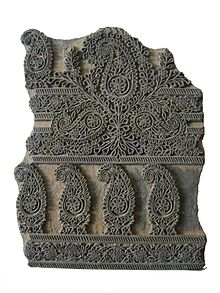Chhipi
 Chhipa, a cloth printer from Tashrih al-aqvam (1825) | |
| Regions with significant populations | |
|---|---|
| India and Pakistan | |
| Languages | |
| Gujarati, Kutchi and Marwari | |
| Religion | |
| Hinduism, Islam | |
| Related ethnic groups | |
| Chhapa or Chhapola |
Chhipi (alternatively called Chhimpa[1]/Chhipa/Chimpa) is a caste of people with ancestral roots tracing back to India. These people are basically Rajputs and used to wear Kshatriya attire.[2] These people were skilled in the art of war, Later people of this caste started doing printing work. They are found in the states of Gujarat, Rajasthan, Madhya Pradesh, Haryana, Delhi, Uttar Pradesh of India.
History

According to historians, the Chhipa were originally a warrior class or Kshatriya Rajput.[3][4][page needed][5][page needed] They used to have a similar lifestyle like a Rajput in which Physical activities such as hunting, and warfare were involved. It is said that once, according to the Hindu epic Mahabharata, Lord Parshuram While killing all the Kshatriyas to avenge their father, two brothers from the Rajput clan took refuge in a temple.[3][6][page needed] one of the presiding deities hid behind the statue And it got its name from the literal 'hide' for the Hindi verb 'Chhipa'. Later Rajput boy printed cloth Or adopted the profession of dyer and he was not originally a Kshatriya. The genealogy of this Rajput child is the 'Chhipa's of today.[3][7]
Present circumstances
India
The community is classified as an OBC caste in the Indian states of Punjab,Haryana, Delhi, Rajasthan, Madhya Pradesh, Uttar Pradesh.[8][9][10][11][12]
Pakistan
Chhipa community is settled in Karachi, Sindh, Pakistan.[13]
See also
References
- ^ Kitts, Eustace John (1885). A Compendium of the Caste and Tribes Found in India: Comp. from the (1881) Census Reports for the Various Provinces (excluding Burmah) and Native States of the Empire. Printed at the Education society's Press.
- ^ People of India: Uttar Pradesh. Anthropological Survey of India. 2005. ISBN 978-81-7304-114-3.
- ^ a b c Singh, Kumar Suresh; Bhanu, B. V.; India, Anthropological Survey of (2004). Maharashtra. Popular Prakashan. ISBN 978-81-7991-100-6.
- ^ Gahlot, Sukhvir Singh; Dhar, Banshi (1989). Castes and Tribes of Rajasthan. Jain Brothers. ISBN 978-81-85287-00-3.
- ^ Mohammada, Malika (2007). The Foundations of the Composite Culture in India. Aakar Books. ISBN 978-81-89833-18-3.
- ^ Neuman, Daniel M.; Chaudhuri, Shubha; Kothari, Komal (2005). Bards, Ballads and Boundaries: An Ethnographic Atlas of Music Traditions in West Rajasthan. Seagull. ISBN 978-1-905422-07-4.
- ^ Das, Nava Kishor (2003). Culture, Religion, and Philosophy: Critical Studies in Syncretism and Inter-faith Harmony. Rawat Publications. ISBN 978-81-7033-820-8.
- ^ Haryana OBC list
- ^ Delhi OBC list
- ^ Rajasthan OBC list
- ^ Madhya Pradesh Obc list
- ^ UP OBC list
- ^ Billah, Mohd Ma'Sum (21 April 2021). Islamic Wealth and the SDGs: Global Strategies for Socio-economic Impact. Springer Nature. ISBN 978-3-030-65313-2.
